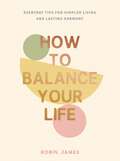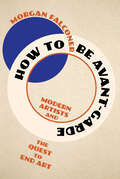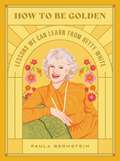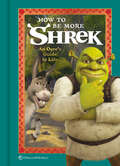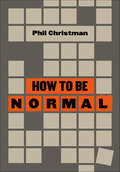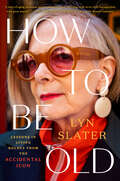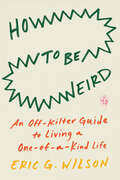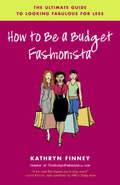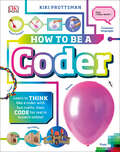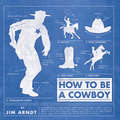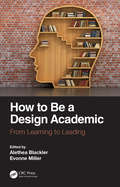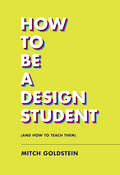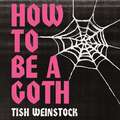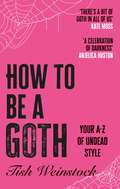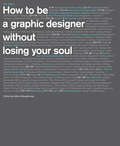- Table View
- List View
How to Audition for TV Commercials
by W. L. JenkinsWhat do ad agencies look for when casting TV commercials? This insider's guide, written by a former actor turned ad agency exec, has the answers. It provides step-by-step instructions to help actors understand and master the entire process, from assessing one's looks and personality to the agency preproduction process, from reading scripts and understanding storyboards to preparing for the audition, doing the shoot, and more.
How to Audition for TV Commercials: From the Ad Agency Point of View
by W. L. JenkinsWhat do ad agencies look for when casting TV commercials? This insider's guide, written by a former actor turned ad agency exec, has the answers. It provides step-by-step instructions to help actors understand and master the entire process, from assessing one's looks and personality to the agency preproduction process, from reading scripts and understanding storyboards to preparing for the audition, doing the shoot, and more.Allworth Press, an imprint of Skyhorse Publishing, publishes a broad range of books on the visual and performing arts, with emphasis on the business of art. Our titles cover subjects such as graphic design, theater, branding, fine art, photography, interior design, writing, acting, film, how to start careers, business and legal forms, business practices, and more. While we don't aspire to publish a New York Times bestseller or a national bestseller, we are deeply committed to quality books that help creative professionals succeed and thrive. We often publish in areas overlooked by other publishers and welcome the author whose expertise can help our audience of readers.
How to Avoid the Ten Biggest Home-Buying Traps
by Patrick Hogan A. M. WatkinsBuying a house can be a wonderful experience if you understand not only what to buy, but also what not to buy. But can you avoid common homebuying mistakes if you don't know what they are? Let How to Avoid the 10 Biggest Homebuying Traps guide you safely through the process of buying your home by showing you what pitfalls to identify and sidestep. With this guidance, you can successfully navigate potential money traps to find the home of your dreams. How To Avoid the 10 Biggest Homebuying Traps reveals the ten most common, and costly, mistakes homebuyers make. Guided by real estate expert Art Watkins, you'll learn how to spot and avoid: Houses that are overpriced for their value New construction by shady builders Homes that are marginal in quality Houses packed with special features for an impulse buy Garbled floor plans that reduce a home's value Homes that are expensive energy guzzlers, and much more.
How to Balance Your Life: Everyday Tips for Simpler Living and Lasting Harmony
by Robin JamesAchieving a sense of equilibrium and inner peace can prove elusive when so many demands and responsibilities are constantly vying for your attention. Discover the tools for finding harmony in all aspects of your life with practical tips on everything from managing everyday stress to finding a work/life balance that is right for you. This inspirational book will help you find ways to maintain a healthy diet and lifestyle and be more mindful of the wider world and your impact upon it, while making sure there is always room for ‘me’ time.Balancing your life is essential to your health and well-being, and by applying a few simple concepts you will live your life at a pace that is comfortable and ultimately rewarding.
How to Balance Your Life: Everyday Tips for Simpler Living and Lasting Harmony
by Robin JamesAchieving a sense of equilibrium and inner peace can prove elusive when so many demands and responsibilities are constantly vying for your attention. Discover the tools for finding harmony in all aspects of your life with practical tips on everything from managing everyday stress to finding a work/life balance that is right for you. This inspirational book will help you find ways to maintain a healthy diet and lifestyle and be more mindful of the wider world and your impact upon it, while making sure there is always room for ‘me’ time.Balancing your life is essential to your health and well-being, and by applying a few simple concepts you will live your life at a pace that is comfortable and ultimately rewarding.
How to Balance Your Life: Everyday Tips for Simpler Living and Lasting Harmony
by Robin JamesFind harmony in all aspects of your life with this beautiful guide to simple, balanced living. With practical tips on everything from managing day-to-day stress to finding a work-life balance, How to Balance Your Life is your go-to guide to discovering lasting peace. So, take your first step towards a happier, healthier and more relaxed future.
How to Balance Your Life: Everyday Tips for Simpler Living and Lasting Harmony
by Robin JamesFind harmony in all aspects of your life with this beautiful guide to simple, balanced living. With practical tips on everything from managing day-to-day stress to finding a work-life balance, How to Balance Your Life is your go-to guide to discovering lasting peace. So, take your first step towards a happier, healthier and more relaxed future.
How to Be Avant-Garde: Modern Artists and the Quest to End Art
by Morgan FalconerOne of Literary Hub's Most Anticipated Books of 2025 The strange story of the twentieth-century artists who sought to destroy art by transforming it into the substance of everyday life. “Art has poisoned our life,” proclaimed Dutch artist and De Stijl cofounder Theo van Doesburg. Reacting to the tumultuous crises of the twentieth century, especially the horrors of World War I, avant-garde artists and writers sought to destroy art by transforming it into the substance of everyday life. Following the evolution of these revolutionary groups, How to Be Avant-Garde charts its pioneers and radical ideas. From Paris to New York, from Zurich to Moscow and Berlin, avant-gardists challenged the confines of the definition of art along with the confines of the canvas itself. Art historian Morgan Falconer starts with the dynamic Futurist founder Filippo Tommaso Marinetti, whose manifesto extolling speed, destruction, and modernity seeded avant-gardes across Europe. In turn, Dadaists Hugo Ball and Emmy Hennings sought to replace art with political cabaret, and the Surrealists tried to exchange it for tools to plumb the unconscious. He guides us through the Russian Constructivists with their adventures in advertising and utopianism and then De Stijl with the geometric abstractions of Piet Mondrian. The Bauhaus broke more boundaries, transmuting art into architecture and design. Finally, the Situationists swapped art for politics, with many of their ideas inspiring the 1968 Paris student protests. How to Be Avant-Garde is a journey through the interlocking networks of these richly creative lives with their visions of a better world, their sometimes sympathetic but often strange and turbulent conversations, and their objects and writings that defied categorization.
How to Be Golden: Lessons We Can Learn from Betty White
by Paula BernsteinIf there's one thing the nation can agree on--we all love Betty White! This spirited homage to Betty captures her unique humor, timeless wisdom, and impish irreverence that's made her one of America's longest lasting and most beloved stars. An unparalleled American icon, Betty White started show business in 1939 in radio and was a pioneer in the early days of TV. Over eight decades, she's appeared on countless sitcoms, game shows, and talk shows, including the iconic comedy hits The Mary Tyler Moore Show and The Golden Girls. Her accolades over the years include two Emmy nominations, a Grammy, and induction into the Television Academy Hall of Fame, while she had her best decade yet as a nonagenarian: becoming the oldest person to host SNL, starring in a Super Bowl ad, and winning praise with her popular supporting role in Hot in Cleveland. Through it all, her "don't take yourself too seriously" attitude appeals to legions of fans, spanning all generations.How to Be Golden recounts her engaging life story while weaving in her words of wisdom and insight about love, friendship, work, family, sex, acting, aging, beauty, and more.
How to Be Like Walt
by Pat Williams Jim DenneyAn inspiring biography of one of the most influential and beloved figures of the 21st century, Walt Disney, based on more than a thousand interviews.
How to Be More Shrek: An Ogre's Guide to Life
by NBC UniversalAn illustrated guide to embracing your inner ogre and living your truth, mud, farts, and all.&“There&’s a lot more to ogres than people think. Ogres are like onions. Onions have layers. Ogres have layers.&” —Shrek With bite-sized advice that feels attainable rather than exhausting, How to Be More Shrek will teach you how to set boundaries, peel back your layers, learn to love your inner (and outer) ogre, fill your swamp with all the right fairytale creatures, and make your own happily ever after. This hilarious book will empower you to have your eyeball jelly on toast and eat it too.
How to Be Normal
by Phil Christman&“Erudite riffs on race, religion, masculinity and [more]. . . . A crisp set of essays that bring big social and cultural debates to a human level.&” —Kirkus Reviews Phil Christman is one of the best cultural critics working today. Or, as a reviewer of his previous book, Midwest Futures, put it, &“one of the most underappreciated writers of [his] generation.&” You may also know Phil from his columns in Commonweal and Plough, or his viral essay &“What Is It Like To Be A Man?&”, the latter adapted in his new book, How to Be Normal. Christman&’s second book includes essays on &“How To Be White,&” &“How to Be Religious,&” &“How To Be Married,&” and more, in addition to new versions of previously published essays. You&’ll also find brilliant analyses of middlebrow culture, bad movies, Mark Fisher, Christian fundamentalism, and more. With exquisite attention to syntax and prose, the astoundingly well-read Christman pairs a deceptively breezy style with radical openness. In his witty, original hands, seemingly &“normal&” subjects are rendered exceptional, and exceptionally. &“A probing and provocative collection.&” —Publishers Weekly &“Engaging a belles-lettristic negative capability, Christman takes on the big subjects while always remembering that the point of criticism is to more fully be a person, part of &‘our little attempts that we make at building a home in this world.&’&” —Ed Simon, The Millions &“Christman charts a frank and fearless guide for the perplexed, the battered, the exhausted, and the outraged.&” —Chris Lehmann, The New Republic &“Earnest and intense.&” —Richard Babcock, Wall Street Journal
How to Be Old: Lessons in Living Boldly from the Accidental Icon
by Lyn SlaterOne of Elle's Most Anticipated Nonfiction Books of 2024A personal memoir in which Lyn Slater, known on Instagram as &“Accidental Icon,&” brings her characteristic style, optimism, forward-thinking, and rules-are-meant-to-be-broken attitude to the question of how to live boldly at any age. When Lyn Slater started her fashion blog, Accidental Icon, at age sixty-one, she discovered that followers were flocking to her account for more than just her A-list style. As Lyn flaunted gray hair, wrinkles, and a megadose of self-acceptance, they found in her an alternative model of older life: someone who defied the stereotypes, refused to become invisible, and showed that all women have the opportunity to be relevant and take major risks at any stage of their life. Youth is not the only time we can be experimental. How to Be Old tells the ten-year story of Lyn&’s sixties, the sometimes-glamorous, sometimes-turbulent decade of Accidental Icon. This memoir is about the hopeful and future-oriented process of reinvention. It shows readers that while you can&’t control everything, what you can control is the way you think about your age and the creative ways you respond to the changes in your mind and body as they happen. Rather than trying to meet standards of youth and beauty as a measure of successful aging, Lyn promotes a more inclusive and empowering standard to judge our older selves by. In this paradigm-shifting memoir, Lyn exemplifies that even with its unique challenges, being old is just like any new beginning in your life and can be the best and most invigorating of all of life&’s phases, full of rebellion and reinvention, connection and creativity.
How to Be Weird: An Off-Kilter Guide to Living a One-of-a-Kind Life
by Eric G. WilsonA guidebook for beating the monotony of the everyday by purposefully cultivating the surprising joys that come from living an off-kilter lifeIt's all too easy to get caught up in the often monotonous nature of our day to day--moving from one rote task to the next, only to rinse and repeat the next day. Weirdness, however, is an easily accessible antidote to these feelings of languishing. The quirky, eccentric, and peculiar can take us out of our normal habits of thought and perception, surprising us by breaking up our routines and reminding us that there's more to life than the everyday. In How to Be Weird, Eric G. Wilson offers 99 fun and philosophically rich exercises for embracing all the weird in the world around us--taking aimless walks, creating a reverie nook, exploring the underside of bridges, making tombstone rubbings, finding your own Narnia, and more.With brief digestible entries on how to make sense of the random, guidelines on how to defamiliarize familiar objects through meditation, and exercises for locating weird states and phenomena for ourselves, How to Be Weird is an invitation to lean into the weird and to live a fuller life.
How to Be a Budget Fashionista: The Ultimate Guide to Looking Fabulous for Less
by Kathryn FinneyGood news: You don’t have to sacrifice style just to pay your electric bill. Kathryn Finney, a.k.a. the Budget Fashionista, is the expert on all things chic and cheap. Now she opens up her Prada bag of shopping and style tips to make you fashionably frugal, with change to spare. It’s as easy as 1-2-3!1. Know your budget: Learn innovative, money-saving ways to increase your clothing funds. 2. Know your style: Get helpful hints from fashion insiders and use them to develop your own mode of self-expression. 3. Know your bargains: Discover the art of scoring exclusive friends-and-family coupons for your favorite department stores Whether you’re a homemaker from Houston, a grandma from Grand Rapids, or an M.D. from Manhattan, you don’t need to break the bank to look your best. With great cost-cutting tips, at-home spa secrets, designer discount websites, and access to exclusive deals, The Budget Fashionista is like having your own personal stylist at your beck and call. So before you go out and commit the eighth deadly sin–buying a fake Louis Vuitton–read this must-have guide and learn to be style-smart and budget-wise!From the Trade Paperback edition.
How to Be a Budget Fashionista®
by Kathryn FinneyGood news: You don’t have to sacrifice style just to pay your electric bill. Kathryn Finney, a. k. a. the Budget Fashionista, is the expert on all things chic and cheap. Now she opens up her Prada bag of shopping and style tips to make you fashionably frugal, with change to spare. It’s as easy as 1-2-3! 1. Know your budget: Learn innovative, money-saving ways to increase your clothing funds. 2. Know your style: Get helpful hints from fashion insiders and use them to develop your own mode of self-expression. 3. Know your bargains: Discover the art of scoring exclusive friends-and- family coupons for your favorite department stores Whether you’re a homemaker from Houston, a grandma from Grand Rapids, or an M. D. from Manhattan, you don’t need to break the bank to look your best. With great cost-cutting tips, at-home spa secrets, designer discount websites, and access to exclusive deals, The Budget Fashionista is like having your own personal stylist at your beck and call. So before you go out and commit the eighth deadly sin–buying a fake Louis Vuitton–read this must-have guide and learn to be style-smart and budget-wise!
How to Be a Coder: Learn to Think like a Coder with Fun Activities, then Code in Scratch 3.0 Online (Careers for Kids)
by Kiki ProttsmanLearn to think like a coder without a computer! Each of the fun craft activities included in this book will teach you about a key concept of computer programming and can be done completely offline. Then you can put your skills into practice by trying out the simple programs provided in the online, child-friendly computer language Scratch.This crafty coding book breaks down the principles of coding into bite-sized chunks that will get you thinking like a computer scientist in no time. Learn about loops by making a friendship bracelet, find out about programming by planning a scavenger hunt, and discover how functions work with paper fortune tellers. Children can then use their new knowledge to code for real by following the clear instructions to build programs in Scratch 3.0.Perfect for kids aged 7-9, the various STEAM activities will help teach children the crucial skills of logical thinking that will give them a head-start for when they begin programming on a computer. Famous scientist pages teach children about coding pioneers, such as Alan Turing and Katherine Johnson, and topic pages, such as the Internet, give kids a wider understanding of the subject.Written by computer science expert Kiki Prottsman, How to be a Coder is so much fun kids won't realize they're learning!
How to Be a Cowboy
by Jim ArndtExplore every facet of being a cowboy with essays and colorful photos in this guide from the author of Buckaroo Boots and Art of the Buckle.How to be a Cowboy is a compendium of knowledge and insight, wit and wisdom, and all-around resource for every aspect of cowboy life. It includes the least you need to know about ranching, rodeoing, cooking, music, dancing, yodeling, lingo (like &“dude,&” &“bronc,&” and &“hoss&”), cowboy poetry, hats, boots (like boot history and how to choose a pair for yourself), spurs, shirts, horses, hats, buckles, denim, and also how to walk like a cowboy. Discover the top twenty cowboy movies and top western novels. You&’ll even find advice from cowboy icon Will Rogers.&“It&’s the rich color camerawork that really compels, and Arndt&’s classy shots of elaborately designed boots, shirts, blue jeans and hats, plus peripheral cowboy gear, are enough to make a guy chuck the 9-to-5 and head out to the wild, wild West.&”—Martin Brady, BookPage
How to Be a Design Academic: From Learning to Leading
by Alethea Blackler and Evonne MillerThis book is about how to be a design academic. In another words, how to manage the various challenges, requirements, and processes that come with both the everyday and extra-ordinary parts of an academic role in design fields (from architecture, urban design, interior design and landscape architecture, to fashion, industrial, interaction and graphic design). The book is organised in two parts – Part 1, Starting out and Part 2, Becoming a Leader. It includes real-life experiences of actual academics and offers a wide range of experiences of authors from early career researchers to full professors and heads of schools. It contains all aspects of academic life, including the highs and lows of teaching, research, leadership, and managing your working life and your career. This book is perfect for academics, aspiring academics, and research students in a wide range of design fields.
How to Be a Design Student (and How to Teach Them)
by Mitch GoldsteinDesigner, artist, and educator Mitch Goldstein's experience as student and teacher gives guidance and inspiration to help students get the most out of design school.Life as a design student is filled with questions. Rochester Institute of Technology Associate Professor of Design Mitch Goldstein has many answers, shared in clear, clever, and sage advice that is helpful for students at any level of their education, as well as anyone thinking about attending design school and wondering what it's really all about.For design students and art professionals, Goldstein is a brilliant resource for real-world thoughts about design school and creative practice. Drawing on 16 years of teaching design and his popular "Dear Design Student" Twitter project, Goldstein explores all aspects of how to get the most out of the school experience, and beyond as a creative professional.From collaboration and critiques to practice and process, this is an inspiring roadmap for design students as well as a valuable guide for design professors to help them understand how to shape curriculum from a student's perspective and better the collaborative experience. Goldstein's insightful essays cover such topics as:Why go to design schoolWhat actually happens in your classes during your time at design schoolWhat kind of assignments you can expectHow critiques workWhat you're actually expected to do on a daily basisHow to translate ideas into paying client projectsHow to make things that will get you a jobAnd much more
How to Be a Fashion Designer (Careers for Kids)
by Lesley Ware"Highly recommended for any aspiring fashionistas." – School Library JournalDesign, style, and accessorize clothes with this fun guide full of practical fashion design ideas for kids!Draw and color creations, choose materials, and learn to design through drawing your own fashion. Packed with practical tips and inspiration, children can enjoy experimenting with new ideas. Illustrations mixed with photography show kids how to choose gorgeous colors, design dress shapes, customize T-shirts, design a bag, pick a color palette, design with texture, and add sparkle to their accessories in simple, easy-to-follow design tasks and simple practical projects. Using inspiration from the natural world, everyday life, and their own imagination, children can design outfits from scratch and learn how to put together the clothes and accessories they already own in fun, stylish ways. Contents support the STEAM (Science, Technology, Engineering, Art, Math) approach to cross-curricular learning.
How to Be a Goth: Notes on Undead Style
by Tish Weinstock'A celebration of darkness' Anjelica Huston'There's a bit of goth in us all' Kate MossAmidst the waking nightmares of our present day, the solace of goth looms to soothe our morbid anxieties.Permeating pop culture at every juncture - fashion, art, music, film, beauty - what was once shrouded in mystery has now slipped into the mainstream.Attempting to make sense of all the madness, this grimoire serves as a manual for the modern goth, as they navigate the pentagram of life. Held within its pages are an inventory of undead icons throughout the ages, from Wednesday Addams to Siouxsie Sioux, as well as style and beauty advice for each stage of a goth's life. Plus, notes on what films to watch, music to wallow to and books to take with you to the grave. To illuminate the darkness further, we hear from notable goths and goth-coded individuals such as Anjelica Huston, Christina Ricci, Michèle Lamy, Amelia Gray and more on what this eldritch culture means to them.Welcome to the season of the witch.
How to Be a Goth: Notes on Undead Style
by Tish Weinstock'A celebration of darkness' Anjelica Huston'There's a bit of goth in us all' Kate MossAmidst the waking nightmares of our present day, the solace of goth looms to soothe our morbid anxieties.Permeating pop culture at every juncture - fashion, art, music, film, beauty - what was once shrouded in mystery has now slipped into the mainstream.Attempting to make sense of all the madness, this grimoire serves as a manual for the modern goth, as they navigate the pentagram of life. Held within its pages are an inventory of undead icons throughout the ages, from Wednesday Addams to Siouxsie Sioux, as well as style and beauty advice for each stage of a goth's life. Plus, notes on what films to watch, music to wallow to and books to take with you to the grave. To illuminate the darkness further, we hear from notable goths and goth-coded individuals such as Anjelica Huston, Christina Ricci, Michèle Lamy, Amelia Gray and more on what this eldritch culture means to them.Welcome to the season of the witch.
How to Be a Goth: Notes on Undead Style
by Tish Weinstock'A celebration of darkness' Anjelica Huston'There's a bit of goth in us all' Kate MossAmidst the waking nightmares of our present day, the solace of goth looms to soothe our morbid anxieties.Permeating pop culture at every juncture - fashion, art, music, film, beauty - what was once shrouded in mystery has now slipped into the mainstream.Attempting to make sense of all the madness, this grimoire serves as a manual for the modern goth, as they navigate the pentagram of life. Held within its pages are an inventory of undead icons throughout the ages, from Wednesday Addams to Siouxsie Sioux, as well as style and beauty advice for each stage of a goth's life. Plus, notes on what films to watch, music to wallow to and books to take with you to the grave. To illuminate the darkness further, we hear from notable goths and goth-coded individuals such as Anjelica Huston, Christina Ricci, Michèle Lamy, Amelia Gray and more on what this eldritch culture means to them.Welcome to the season of the witch.
How to Be a Graphic Designer without Losing Your Soul: Without Losing Your Soul
by Adrian ShaughnessyPublished to instant acclaim in 2005, our best selling How to Be a Graphic Designer without Losing Your Soul has become a trusted resource for graphic designers around the world, combining practical advice with philosophical guidance to help young professionals embark on their careers. This new, expanded edition brings this essential text up to date with new chapters on professional skills, the creative process, and global trends that include social responsibility, ethics, and the rise of digital culture. How to Be a Graphic Designer offers clear, concise guidance along with focused, no-nonsense strategies for setting up, running, and promoting a studio; finding work; and collaborating with clients. The book also includes inspiring new interviews with leading designers, including Jonathan Barnbrook, Sara De Bondt, Stephen Doyle, Ben Drury, Paul Sahre, Dmitri Siegel, Sophie Thomas, and Magnus Vol Mathiassen




